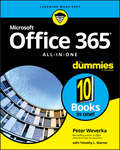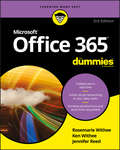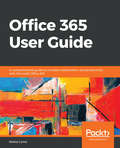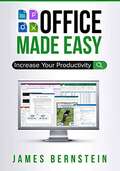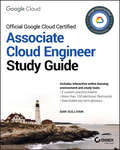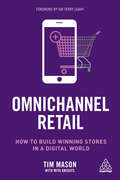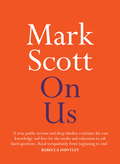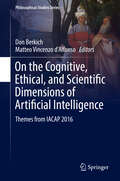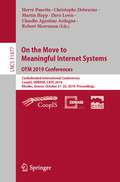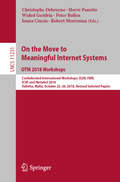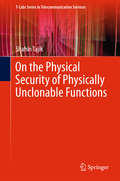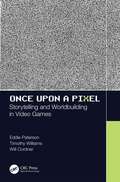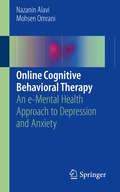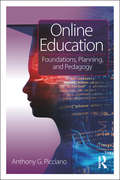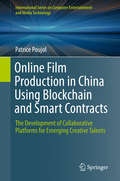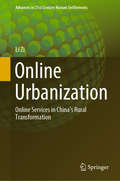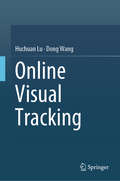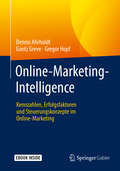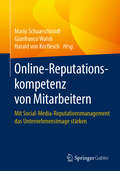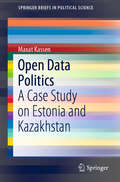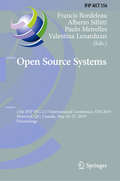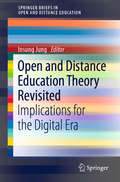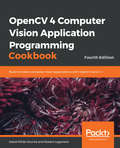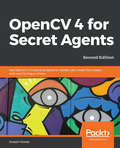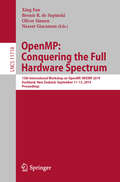- Table View
- List View
Office 365 All-in-One For Dummies
by Peter WeverkaThe deepest reference on Microsoft’s productivity service Office 365 offers the same productivity power as past versions of Microsoft Office along with tools designed to boost collaboration in the workplace and instant access to the latest Office updates without buying a whole new software package. It’s an ideal solution for both the office and home use. The author of the bestselling Office All-in-One For Dummies shares his advice on how to navigate the nuts and bolts of getting things done with Office 365. Look inside for step-by-step instructions on Excel, Outlook, Word, PowerPoint, Access, and OneNote along with a dive into the cloud services that come with Office 365. Access Office 365 Make sense of common Office tasks Use Excel, Word, outlook, PowerPoint and more Take advantage of 365 online services If you’re a home or business user interested in having a complete reference on the suite, this book has you covered.
Office 365 For Dummies
by Ken Withee Jennifer Reed Rosemarie WitheeEverything you need to get productive in the Cloud with Office 365 With 70 million users worldwide, Microsoft Office 365 combines the familiar Office desktop suite with cloud-based versions of Microsoft’s next-generation communications and collaboration services. It offers many benefits including security, reliability, compatibility with other products, over-the-air updates in the cloud that don't require anything from the user, single sign on for access to everything right away, and so much more. Office 365 For Dummies offers a basic overview of cloud computing and goes on to cover Microsoft cloud solutions and the Office 365 product in a language you can understand. This includes an introduction to each component which leads into topics around using each feature in each application. Get up to speed on instant messaging Use audio, video, and web conferencing Get seamless access to the Office suite with Office Web apps Access information anywhere, anytime Office 365 is the key to office productivity — and now you can put it to use for you!
Office 365 User Guide: A comprehensive guide to increase collaboration and productivity with Microsoft Office 365
by Nikkia CarterWork with the powerful subscription software, Office 365 to increase your organization's efficiency by managing file sharing, email exchange and much more.Key FeaturesBecome well versed with Office 365 and leverage its capabilities for your businessSpeed up your workflow and effectively collaborate using Office Web AppsLearn to set audio and web conferences and seamlessly access your workspaceBook DescriptionMicrosoft Office 365 combines the popular Office suite with next-generation cloud computing capabilities. With this user guide, you'll be able to implement its software features for effective business communication and collaboration. This book begins by providing you with a quick introduction to the user interface (UI) and the most commonly used features of Office 365. After covering the core aspects of this suite, you'll learn how to perform various email functions via Exchange. Next, you will learn how to communicate using Skype for Business and Microsoft Teams. To boost your productivity, this book will help you learn everything from using instant messaging to conducting audio and web conferences, and even accessing business information from any location. In the final chapters, you will learn to work in a systematic style using file management and collaboration with OneDrive for Business using SharePoint.By the end of this book, you'll be equipped with the knowledge you need to take full advantage of Office 365 and level up your organization's productivity.What you will learnUnderstand the UI of Office 365Perform a variety of email functions through ExchangeCommunicate using Skype for Business and Microsoft TeamsExplore file management using OneDrive for BusinessCollaborate using SharePointUnderstand how to leverage Office 365 in your daily tasksWho this book is forIf you are an IT professional who wants to upgrade your traditional Office suite, this book is for you. Users looking to learn, configure, manage, and maintain an Office 365 environment in their organization will also find this book useful. Some understanding of Microsoft Office Suite and cloud computing basics will be beneficial.
Office Made Easy: Increase Your Productivity (Computers Made Easy)
by James BernsteinLearn How to Use Microsoft Office With This Easy to Follow Step by Step Guide. <p><p>Office Made Easy was written to take your overall office skills from a beginner to the next level of productivity. The book is based on Office 2016 but will apply to Office 2007-2019 since the functionality is basically the same. With this book you will get a top level understanding without a need for a complex education. This easy to use guide will help you navigate your way to becoming proficient with the Microsoft Office Suite of programs.
Official Google Cloud Certified Associate Cloud Engineer Study Guide
by Dan SullivanThe Only Official Google Cloud Study Guide The Official Google Cloud Certified Associate Cloud Engineer Study Guide, provides everything you need to prepare for this important exam and master the skills necessary to land that coveted Google Cloud Engineering certification. Beginning with a pre-book assessment quiz to evaluate what you know before you begin, each chapter features exam objectives and review questions, plus the online learning environment includes additional complete practice tests. Written by Dan Sullivan, a popular and experienced online course author for machine learning, big data, and Cloud topics, Official Google Cloud Certified Associate Cloud Engineer Study Guide is your ace in the hole for deploying and managing Google Cloud Services. • Select the right Google service from the various choices based on the application to be built • Compute with Cloud VMs and managing VMs • Plan and deploying storage • Network and configure access and security Google Cloud Platform is a leading public cloud that provides its users to many of the same software, hardware, and networking infrastructure used to power Google services. Businesses, organizations, and individuals can launch servers in minutes, store petabytes of data, and implement global virtual clouds with the Google Cloud Platform. Certified Associate Cloud Engineers have demonstrated the knowledge and skills needed to deploy and operate infrastructure, services, and networks in the Google Cloud. This exam guide is designed to help you understand the Google Cloud Platform in depth so that you can meet the needs of those operating resources in the Google Cloud.
Omnichannel Retail: How to build winning stores in a digital world
by Tim Mason Miya KnightsAccording to many reports, the physical retail experience is in crisis as more and more consumers shift to internet shopping. Despite this, the majority of global purchases still happen offline, from 90% of sales in the US through to 92% of sales in the UK and 94% in China. The big change is that today's shopper seeks content and advice online before buying in store. Omnichannel Retail celebrates all the advantages of the physical shopping experience, from its sensory selection through to try-before-you buy, and its potential for providing an instant and profitable retail solution, while explaining the imperative of bringing the power of digital and an omnichannel experience to everyday shopping. Connecting the digital customer to the physical customer, Omnichannel Retail delivers a wealth of opportunities for the bricks and mortar store, including an enhanced customer journey, effortlessly tailoring specific products to a particular customer, exploiting surge pricing, upselling lucrative products and above all, building real, and profitable, relationships with your best customers. Based on over thirty years in loyalty marketing, Tim Mason diligently addresses the challenges facing retailers, providing tangible and proven solutions to capitalize on the changing retail landscape.
On Us
by Mark ScottStop. Listen. Step outside the echo chamber.How do we step outside our own echo chamber to understand others? What are we losing when we share fewer and fewer national moments? The new media is enabling despots and disempowering democracy. So when every opinion seems to matter equally, ON US invites us to switch our devices off and to read uninterrupted. It contemplates why more information often means less insight.
On the Cognitive, Ethical, and Scientific Dimensions of Artificial Intelligence: Themes from IACAP 2016 (Philosophical Studies Series #134)
by Don Berkich Matteo Vincenzo D’AlfonsoThis edited volume explores the intersection between philosophy and computing. It features work presented at the 2016 annual meeting of the International Association for Computing and Philosophy. The 23 contributions to this volume neatly represent a cross section of 40 papers, four keynote addresses, and eight symposia as they cut across six distinct research agendas. The volume begins with foundational studies in computation and information, epistemology and philosophy of science, and logic. The contributions next examine research into computational aspects of cognition and philosophy of mind. This leads to a look at moral dimensions of man-machine interaction as well as issues of trust, privacy, and justice. This multi-disciplinary or, better yet, a-disciplinary investigation reveals the fruitfulness of erasing distinctions among and boundaries between established academic disciplines. This should come as no surprise. The computational turn itself is a-disciplinary and no former discipline, whether scientific, artistic, or humanistic, has remained unchanged. Rigorous reflection on the nature of these changes opens the door to inquiry into the nature of the world, what constitutes our knowledge of it, and our understanding of our place in it. These investigations are only just beginning. The contributions to this volume make this clear: many encourage further research and end with open questions.
On the Move to Meaningful Internet Systems: Confederated International Conferences: CoopIS, ODBASE, C&TC 2019, Rhodes, Greece, October 21–25, 2019, Proceedings (Lecture Notes in Computer Science #11877)
by Christophe Debruyne Hervé Panetto Robert Meersman Claudio Agostino Ardagna Dave Lewis Martin HeppThis volume LNCS 11877 constitutes the refereed proceedings of the Confederated International Conferences: Cooperative Information Systems, CoopIS 2019, Ontologies, Databases, and Applications of Semantics, ODBASE 2019, and Cloud and Trusted Computing, C&TC, held as part of OTM 2019 in October 2019 in Rhodes, Greece. The 38 full papers presented together with 8 short papers were carefully reviewed and selected from 156 submissions. The OTM program every year covers data and Web semantics, distributed objects, Web services, databases, informationsystems, enterprise workflow and collaboration, ubiquity, interoperability, mobility, grid and high-performance computing.
On the Move to Meaningful Internet Systems: Confederated International Workshops: EI2N, FBM, ICSP, and Meta4eS 2018, Valletta, Malta, October 22–26, 2018, Revised Selected Papers (Lecture Notes in Computer Science #11231)
by Wided Guédria Christophe Debruyne Hervé Panetto Robert Meersman Ioana Ciuciu Peter BollenThis volume constitutes the refereed proceedings of the Confederated International International Workshop on Enterprise Integration, Interoperability and Networking (EI2N ), Fact Based Modeling ( FBM), Industry Case Studies Program ( ICSP ), and International Workshop on Methods, Evaluation, Tools and Applications for the Creation and Consumption of Structured Data for the e-Society (Meta4eS), held as part of OTM 2018 in October 2018 in Valletta, Malta.As the three main conferences and the associated workshops all share the distributed aspects of modern computing systems, they experience the application pull created by the Internet and by the so-called Semantic Web, in particular developments of Big Data, increased importance of security issues, and the globalization of mobile-based technologies.
On the Physical Security of Physically Unclonable Functions (T-Labs Series in Telecommunication Services)
by Shahin TajikThis book investigates the susceptibility of intrinsic physically unclonable function (PUF) implementations on reconfigurable hardware to optical semi-invasive attacks from the chip backside. It explores different classes of optical attacks, particularly photonic emission analysis, laser fault injection, and optical contactless probing. By applying these techniques, the book demonstrates that the secrets generated by a PUF can be predicted, manipulated or directly probed without affecting the behavior of the PUF. It subsequently discusses the cost and feasibility of launching such attacks against the very latest hardware technologies in a real scenario. The author discusses why PUFs are not tamper-evident in their current configuration, and therefore, PUFs alone cannot raise the security level of key storage. The author then reviews the potential and already implemented countermeasures, which can remedy PUFs’ security-related shortcomings and make them resistant to optical side-channel and optical fault attacks. Lastly, by making selected modifications to the functionality of an existing PUF architecture, the book presents a prototype tamper-evident sensor for detecting optical contactless probing attempts.
Once Upon a Pixel: Storytelling and Worldbuilding in Video Games
by Eddie Paterson Timothy Simpson-Williams Will CordnerOnce Upon a Pixel examines the increasing sophistication of storytelling and worldbuilding in modern video games. Drawing on some of gaming’s most popular titles, including Red Dead Redemption 2, The Last of Us, Horizon Zero Dawn, and the long-running Metal Gear Solid series, it is a pioneering exploration into narrative in games from the perspective of the creative writer. With interviews and insights from across the industry, it provides a complete account of how Triple-A, independent, and even virtual reality games are changing the way we tell stories. Key Features A fresh perspective on video games as a whole new form of creative writing. Interviews with a range of leading industry figures, from critics to creators. Professional analysis of modern video game script excerpts. Insights into emerging technologies and the future of interactive storytelling.
Online Cognitive Behavioral Therapy: An E-mental Health Approach to Depression and Anxiety
by Nazanin Alavi Mohsen OmraniThis book aims to provide the clinicians with details of online cognitive behavioral therapy (CBT) to facilitate care delivery for patients struggle with depression and anxiety. Chapters cover some of the most fundamental concepts for successful treatment, including experiments, action plans evidence, and the guidelines for managing, thoughts, feelings, and other key concerns. Designed to be a reader-friendly guide, each chapter opens with a summary of the content and a recap of concepts covered in previous sections, making this highly functional for individual chapter or whole book use. Each chapter also includes recommended tables and chart to facilitate the documentation of each recommended session, making this highly practical resource a vital tool for those who treat patients suffering from these particular mental health concerns.
Online Education: Foundations, Planning, and Pedagogy
by Anthony G. Picciano<i>Online Education</i> is a comprehensive exploration of blended and fully online teaching platforms, addressing history, theory, research, planning, and practice. As colleges, universities, and schools around the world adopt large-scale technologies and traditional class models shift into seamless, digitally interactive environments, critical insights are needed into the implications for administration and pedagogy. Written by a major contributor to the field, this book contextualizes online education in the past and present before analyzing its fundamental changes to instruction, program integration, social interaction, content construction, networked media, policy, and more. A provocative concluding chapter speculates on the future of education as the sector becomes increasingly dependent on learning technologies.
Online Film Production in China Using Blockchain and Smart Contracts: The Development of Collaborative Platforms for Emerging Creative Talents (International Series on Computer Entertainment and Media Technology)
by Patrice PoujolThis book explores the use of Blockchain and smart contract technologies to develop new ways to finance independent films and digital media worldwide. Using case studies of Alibaba and in-depth, on-set observation of a Sino-US coproduction, as well as research collected from urban China, Hong Kong, Europe, and the USA, Online Film Production in China Using Blockchain and Smart Contracts explores new digital platforms and what this means for the international production of creative works. This research assesses the change in media consciousness from young urban audiences, their emergence as a potential participative and creative community within dis-intermediated, decentralised and distributed crowdfunding and crowdsourcing models. This research proposes solutions on how these young emerging local creative talents can be identified and nurtured early on, particularly those who now produce creative and artistic audiovisual content whether these works are related to film, Virtual Reality (VR), video game, graphic novels, or music. Ultimately, a new media content finance and production platform implementing blockchain is proposed to bring transparency in the film sector and open doors to emerging artists in digital media. Appropriate for both professionals and academics in the film industry as well as computer science.
Online Urbanization: Online Services in China’s Rural Transformation (Advances in 21st Century Human Settlements)
by Li ZiThis book highlights the new urban–rural relationship that has emerged under the influence of e-commerce in China. In this regard, it presents case studies on the Suichang rural e-commerce model and Alibaba’s rural strategy, together with analyses of online service in China. Furthermore, by means of a brief review of the urban–rural relationship throughout China’s history, and of academic literature on the study of space, it explains the special logic of urbanization in China. As such, the book makes a valuable contribution to the body of literature on the space of flows and grassrooting, aspects that are essential to appreciating the complexity of the new urban–rural relationship in underdeveloped areas (including developing countries and underdeveloped areas in developed countries) in the ongoing information era.
Online Visual Tracking
by Huchuan Lu Dong WangThis book presents the state of the art in online visual tracking, including the motivations, practical algorithms, and experimental evaluations. Visual tracking remains a highly active area of research in Computer Vision and the performance under complex scenarios has substantially improved, driven by the high demand in connection with real-world applications and the recent advances in machine learning. A large variety of new algorithms have been proposed in the literature over the last two decades, with mixed success.Chapters 1 to 6 introduce readers to tracking methods based on online learning algorithms, including sparse representation, dictionary learning, hashing codes, local model, and model fusion. In Chapter 7, visual tracking is formulated as a foreground/background segmentation problem, and tracking methods based on superpixels and end-to-end deep networks are presented. In turn, Chapters 8 and 9 introduce the cutting-edge tracking methods based on correlation filter and deep learning. Chapter 10 summarizes the book and points out potential future research directions for visual tracking. The book is self-contained and suited for all researchers, professionals and postgraduate students working in the fields of computer vision, pattern recognition, and machine learning. It will help these readers grasp the insights provided by cutting-edge research, and benefit from the practical techniques available for designing effective visual tracking algorithms. Further, the source codes or results of most algorithms in the book are provided at an accompanying website.
Online-Marketing-Intelligence: Kennzahlen, Erfolgsfaktoren und Steuerungskonzepte im Online-Marketing
by Dennis Ahrholdt Goetz Greve Gregor HopfDieses Buch bietet eine bislang einzigartige Übersicht über Kennzahlen der wichtigsten Online-Marketinginstrumente verbunden mit einer fundierten Betrachtung der Instrumente und Erfolgszusammenhängen aus empirischen Forschungsergebnissen.Aufgrund der Fülle an verfügbaren Instrumenten und Daten fehlt dem Marketing-Management häufig ein Überblick, mit welchen Kennzahlen sich der Erfolgsbeitrag ihrer Online-Marketing-Aktivitäten bestmöglich messen und dokumentieren lässt. Somit fällt auch die Entscheidung zur Ausgestaltung der Online-Marketing-Aktivitäten schwer: Das Verständnis über Erfolgszusammenhänge ist häufig nur rudimentär vorhanden. Die Autoren beschreiben über 150 Kennzahlen, die in unterschiedlichen Kontexten und entlang der Customer Journey eingesetzt werden können. Sie geben auch Hilfestellungen für die Entwicklung einer Online-Marketing-Intelligence. Das Ziel: trotz zunehmender Komplexität der Online-Marketing-Instrumente eine bestmögliche Budgetallokation zu erreichen. Auch dafür haben sie aus empirischen Forschungsergebnissen instrumentspezifische Erfolgszusammenhänge und -Faktoren für den Business-Alltag extrahiert.Der Praktiker findet in diesem Buch eine Fülle von Handlungsempfehlungen für sein Online-Marketing, um es – auch unter Berücksichtigung empirisch identifizierter Erfolgszusammenhänge – auf state-of-the-art Niveau zu betreiben.
Online-Reputationskompetenz von Mitarbeitern: Mit Social-Media-Reputationsmanagement das Unternehmensimage stärken
by Gianfranco Walsh Mario Schaarschmidt Harald Von Korflesch?In diesem Buch dreht sich alles um das Online-Reputationsmanagement. Dabei geht es um die Fragen, wie Mitarbeiter Social Media nutzen und welchen Einfluss Sie damit auf das Image eines Unternehmens haben können.Mit klaren Handlungsanweisungen zeigt Ihnen dieses Buch, wie Sie mithilfe eines sinnvollen Online-Reputationsmanagements Ihre Mitarbeiter in Bezug auf Risiken und Gefahren, die von Social Media ausgehen, wappnen können.Die Autoren beschäftigen sich mit verschiedenen Phänomenen, die in Zusammenhang mit den Mitarbeitern eines Unternehmens interessant sind. Es geht beispielsweise um Strategien zur Messung der Social-Media-Kompetenz eines Mitarbeiters in Bezug auf die Unternehmensreputation oder die Analyse von Unternehmensbewertungsportalen.
Open Data Politics: A Case Study on Estonia and Kazakhstan (SpringerBriefs in Political Science)
by Maxat KassenThis book offers a cross-national comparison of open data policies in Estonia and Kazakhstan. By analyzing a broad range of open data-driven projects and startups in both countries, it reveals the potential that open data phenomena hold with regard to promoting public sector innovations. The book addresses various political and socioeconomic contexts in these two transitional societies, and reviews the strategies and tactics adopted by policymakers and stakeholders to identify drivers of and obstacles to the implementation of open data innovations. Given its scope, the book will appeal to scholars, policymakers, e-government practitioners and open data entrepreneurs interested in implementing and evaluating open data-driven public sector projects.
Open Source Systems: 15th IFIP WG 2.13 International Conference, OSS 2019, Montreal, QC, Canada, May 26–27, 2019, Proceedings (IFIP Advances in Information and Communication Technology #556)
by Alberto Sillitti Francis Bordeleau Paulo Meirelles Valentina LenarduzziThis open access book constitutes the refereed proceedings of the 15th IFIP WG 2.13 International Conference on Open Source Systems, OSS 2019, held in Montreal, Quebec, Canada, in May 2019.The 10 revised full papers and 5 short papers presented were carefully reviewed and selected from 35 submissions. The papers cover a wide range of topics in the field of free/libre open source software (FLOSS) and are organized in the following thematic sections: mining OSS data; organizational aspects of FLOSS projects; FLOSS adoption; FLOSS cost and licenses; and FLOSS education and training.
Open and Distance Education Theory Revisited: Implications for the Digital Era (SpringerBriefs in Education)
by Insung JungThis book explores foundational theories that have been applied in open and distance education (ODE) research and refined to reflect advances in research and practice. In addition, it develops new theories emerging from recent developments in ODE. The book provides a unique and up-to-date source of information for ODE scholars and graduate students, enabling them to make sense of essential theory, research and practice in their field, and to comprehend the gaps in, and need for further enquiry into, theoretical approaches in the digital era. It also offers theory-based advice and guidelines for practitioners, helping them make and justify decisions and actions concerning the development, implementation, research and evaluation of ODE.
OpenCV 4 Computer Vision Application Programming Cookbook: Build complex computer vision applications with OpenCV and C++, 4th Edition
by Robert Laganiere David Millán EscriváDiscover interesting recipes to help you understand the concepts of object detection, image processing, and facial detectionKey FeaturesExplore the latest features and APIs in OpenCV 4 and build computer vision algorithmsDevelop effective, robust, and fail-safe vision for your applicationsBuild computer vision algorithms with machine learning capabilitiesBook DescriptionOpenCV is an image and video processing library used for all types of image and video analysis. Throughout the book, you'll work through recipes that implement a variety of tasks, such as facial recognition and detection. With 70 self-contained tutorials, this book examines common pain points and best practices for computer vision (CV) developers. Each recipe addresses a specific problem and offers a proven, best-practice solution with insights into how it works, so that you can copy the code and configuration files and modify them to suit your needs.This book begins by setting up OpenCV, and explains how to manipulate pixels. You'll understand how you can process images with classes and count pixels with histograms. You'll also learn detecting, describing, and matching interest points. As you advance through the chapters, you'll get to grips with estimating projective relations in images, reconstructing 3D scenes, processing video sequences, and tracking visual motion. In the final chapters, you'll cover deep learning concepts such as face and object detection.By the end of the book, you'll be able to confidently implement a range to computer vision algorithms to meet the technical requirements of your complex CV projectsWhat you will learnInstall and create a program using the OpenCV librarySegment images into homogenous regions and extract meaningful objectsApply image filters to enhance image contentExploit image geometry to relay different views of a pictured sceneCalibrate the camera from different image observationsDetect people and objects in images using machine learning techniquesReconstruct a 3D scene from imagesExplore face detection using deep learningWho this book is forIf you’re a CV developer or professional who already uses or would like to use OpenCV for building computer vision software, this book is for you. You’ll also find this book useful if you’re a C++ programmer looking to extend your computer vision skillset by learning OpenCV.
OpenCV 4 for Secret Agents: Use OpenCV 4 in secret projects to classify cats, reveal the unseen, and react to rogue drivers, 2nd Edition
by Joseph HowseTurn futuristic ideas about computer vision and machine learning into demonstrations that are both functional and entertainingKey FeaturesBuild OpenCV 4 apps with Python 2 and 3 on desktops and Raspberry Pi, Java on Android, and C# in UnityDetect, classify, recognize, and measure real-world objects in real-timeWork with images from diverse sources, including the web, research datasets, and various camerasBook DescriptionOpenCV 4 is a collection of image processing functions and computer vision algorithms. It is open source, supports many programming languages and platforms, and is fast enough for many real-time applications. With this handy library, you’ll be able to build a variety of impressive gadgets.OpenCV 4 for Secret Agents features a broad selection of projects based on computer vision, machine learning, and several application frameworks. To enable you to build apps for diverse desktop systems and Raspberry Pi, the book supports multiple Python versions, from 2.7 to 3.7. For Android app development, the book also supports Java in Android Studio, and C# in the Unity game engine. Taking inspiration from the world of James Bond, this book will add a touch of adventure and computer vision to your daily routine. You’ll be able to protect your home and car with intelligent camera systems that analyze obstacles, people, and even cats. In addition to this, you’ll also learn how to train a search engine to praise or criticize the images that it finds, and build a mobile app that speaks to you and responds to your body language.By the end of this book, you will be equipped with the knowledge you need to advance your skills as an app developer and a computer vision specialist.What you will learnDetect motion and recognize gestures to control a smartphone gameDetect car headlights and estimate their distanceDetect and recognize human and cat faces to trigger an alarmAmplify motion in a real-time video to show heartbeats and breathsMake a physics simulation that detects shapes in a real-world drawingBuild OpenCV 4 projects in Python 3 for desktops and Raspberry PiDevelop OpenCV 4 Android applications in Android Studio and UnityWho this book is forIf you are an experienced software developer who is new to computer vision or machine learning, and wants to study these topics through creative projects, then this book is for you. The book will also help existing OpenCV users who want upgrade their projects to OpenCV 4 and new versions of other libraries, languages, tools, and operating systems. General familiarity with object-oriented programming, application development, and usage of operating systems (OS), developer tools, and the command line is required.
OpenMP: 15th International Workshop on OpenMP, IWOMP 2019, Auckland, New Zealand, September 11–13, 2019, Proceedings (Lecture Notes in Computer Science #11718)
by Bronis R. de Supinski Xing Fan Oliver Sinnen Nasser GiacamanThis book constitutes the proceedings of the 15th International Workshop on Open MP, IWOMP 2019, held in Auckland, New Zealand, in September 2019. The 22 full papers presented in this volume were carefully reviewed and selected for inclusion in this book. The papers are organized in topical sections named: best paper; tools, accelerators, compilation, extensions, tasking, and using OpenMP.
